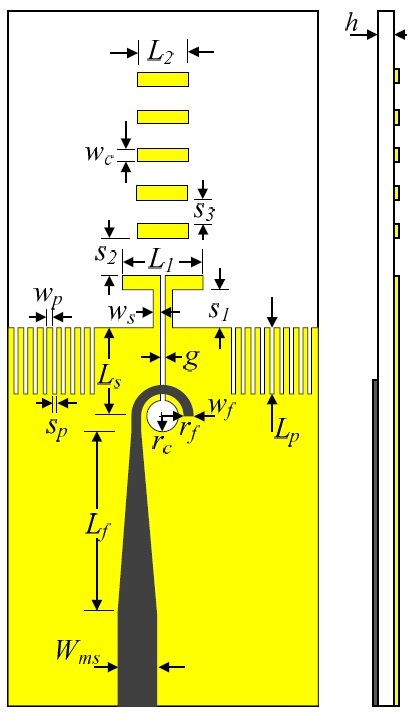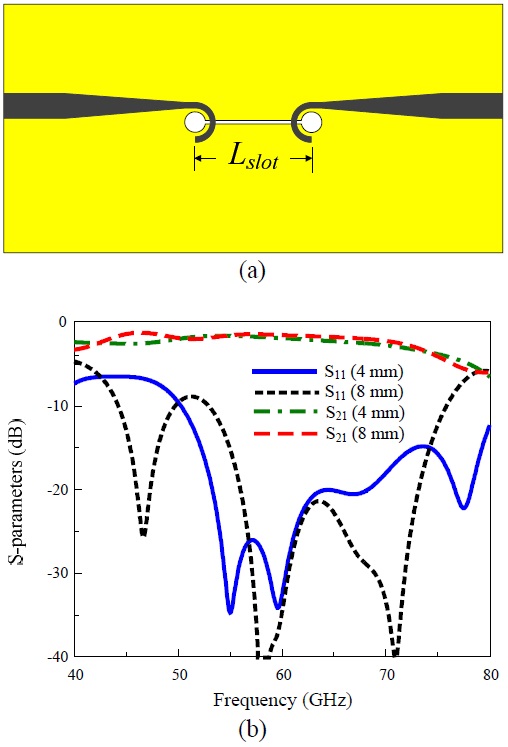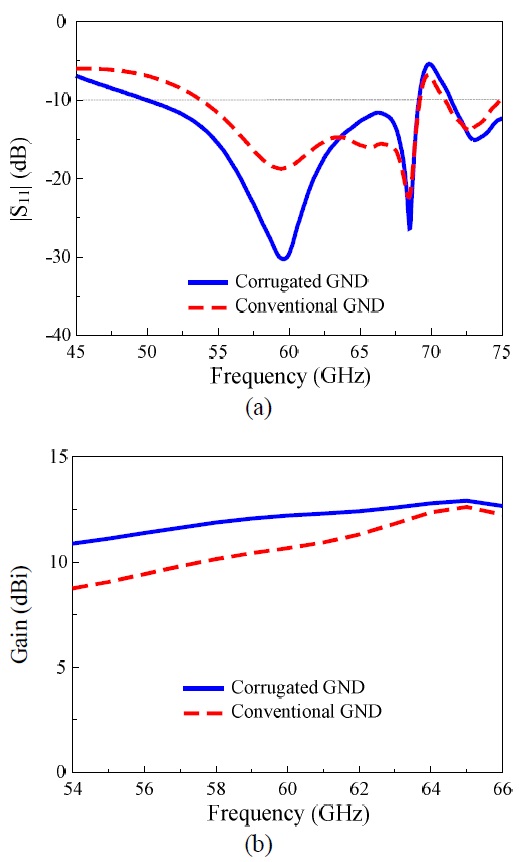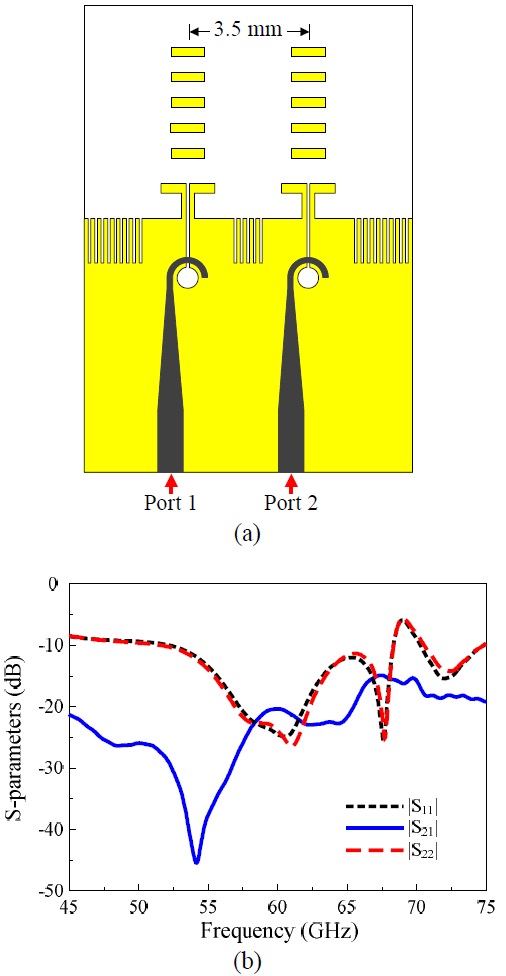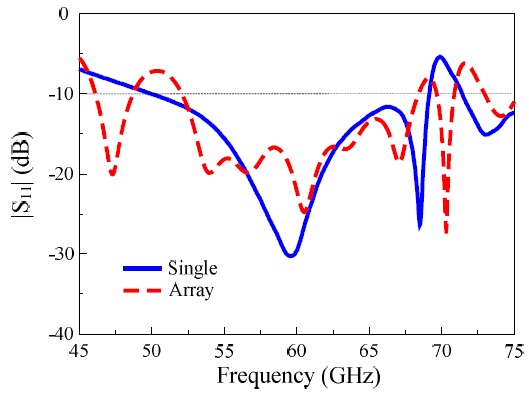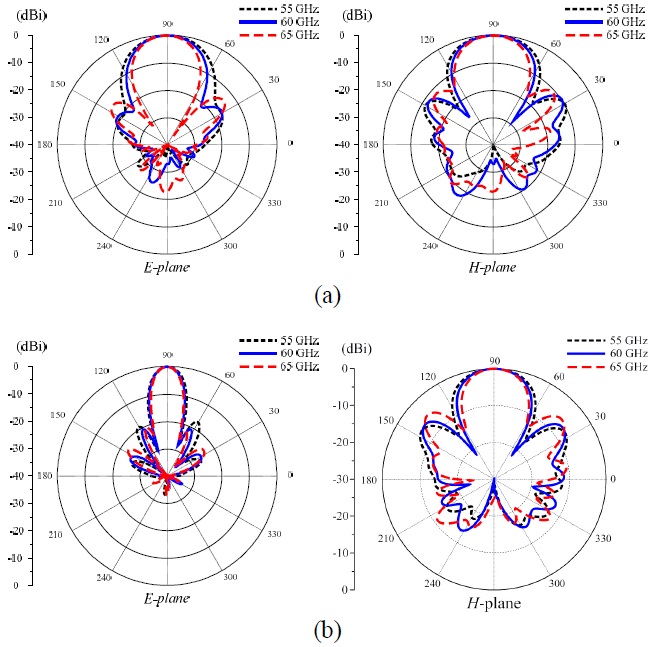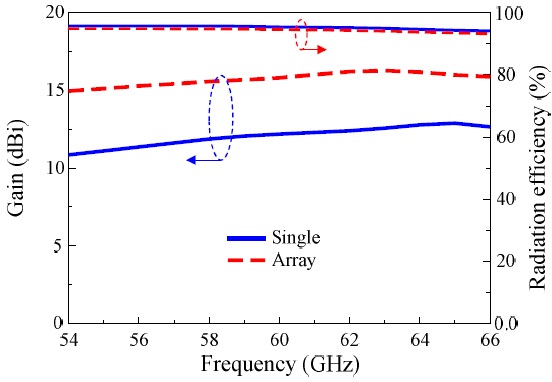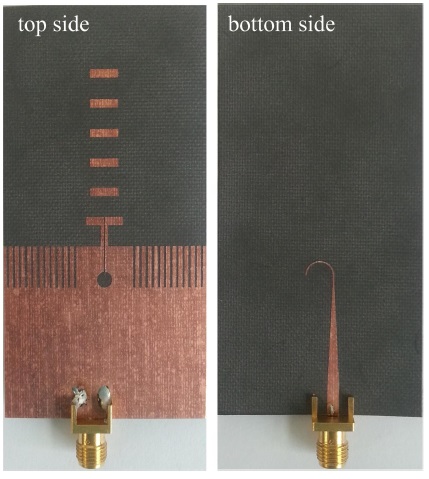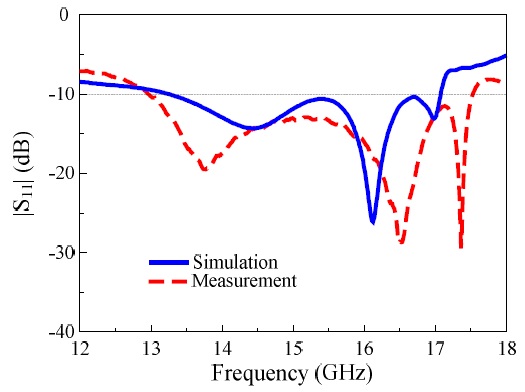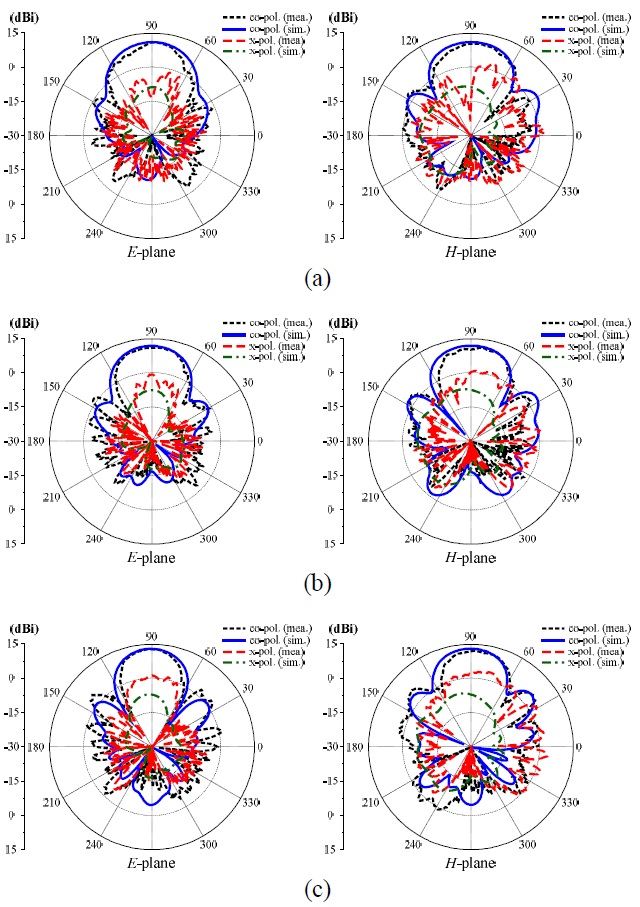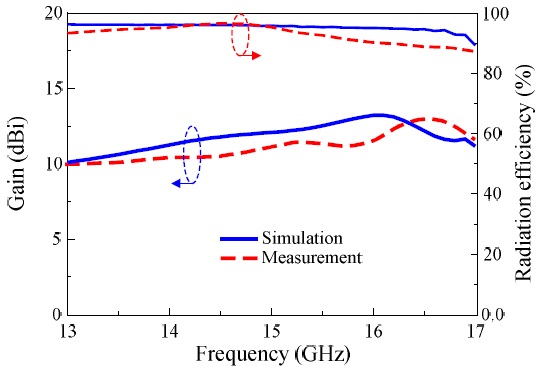



Antennas for 60-GHz high-throughput and short-distance systems have been attracting considerable attention in the past few years because of the wide bandwidth and high atmospheric absorption offered by unlicensed wireless communications near the 60-GHz bands. In general, 60-GHz band antennas for wireless communication applications must be wideband, highly directive, low-profile, lightweight, low-cost, and easy to fabricate [1]. Accordingly, a quasi-Yagi antenna [2-7] is particularly suitable for 60-GHz applications because, unlike other designs [8-13], it satisfies all the above requirements.
Various models of quasi-Yagi antennas have been introduced for 60-GHz wireless communications. For example, a CPW-fed Yagi antenna has been fabricated using a complementary metal-oxide-semiconductor compatible manufacturing technology [14]. A microstrip-fed Yagi-Uda antenna has been incorporated with metal-planes for shielding purposes [15]. A stacked Yagi antenna with a small footprint was presented in [16]. A substrate-integrated waveguide Yagi-Uda antenna having the advantages of low profile and light weight was reported in [17]. A four-element printed Yagi-Uda array using 18 directors was also proposed in [18]. However, most of these quasi-Yagi antennas lack the impedance bandwidth required to cover the entire 60-GHz bands (57 to 66 GHz).
This paper describes a microstrip-to-slotline transitionfed quasi-Yagi antenna and its four-element array designed for 60-GHz wireless communication systems. A corrugated ground plane and five parasitic strips were employed as the reflector and directors of the antenna, respectively, to achieve a high level of directivity and small gain variation. The antennas yielded a broad impedance matching bandwidth as well as high radiation efficiency and high gain. We demonstrated the antenna characteristics, while simultaneously reducing the cost of the measurement process, by fabricating and measuring a scaled-up design of the proposed antenna operating at 15 GHz. The measurements resulted in an impedance bandwidth of 29.5% with a peak gain of 13.2 dBi and radiation efficiency better than 88%.
Fig. 1 shows the geometry of a high-gain 60-GHz printed quasi-Yagi antenna. The antenna was designed on an 8 mm×22 mm Rogers RT/Duroid 5880 substrate with a dielectric constant of 2.2 and a loss tangent of 0.0009. The antenna was composed of a microstrip-to-slotline transition as the feed with an input impedance of 50 Ω, a truncated ground plane as a reflector, a printed dipole driver, and five parasitic strip directors. The 5 parasitic directors were chosen for the proposed antenna in order to achieve directivity greater than 10 dBi and the initial dimensions of the antenna were obtained from a table for maximum directivity in air [19] and then scaled to compensate for the RT/Duroid 5800 substrate and to achieve the maximum directivity. The ground plane was corrugated to improve the antenna gain with small gain variation. The antenna was fed by a novel microstrip-to-slotline transition, specially designed for 60-GHz bands.
A full-wave electromagnetic simulator, the finite integration technique-based Microwave Studio by Computer Simulation Technology (MWS-CST), was used to investigate the characteristics of the proposed antenna. The design parameters of the optimized antenna were chosen in terms of wide impedance bandwidth, high directivity, and small gain variation, as follows:
2. Microstrip-to-Slotline Transition
As mentioned above, the 60-GHz printed quasi-Yagi antenna was fed by a novel microstrip-slotline transition that was specially designed for 60 GHz bands. Fig. 2(a) shows the back-to-back transition structure and Fig. 2(b) plots its simulated S-parameters for different slotline lengths (
The corrugated ground plane was employed as a magnetic ground plane edge to improve the front-to-back ratio at a given frequency [20]. On the other hand, the proposed antenna utilized a corrugated ground plane to enhance the bandwidth and improve the gain in the low-frequency region of the operating bandwidth. This can be observed in Fig. 3, which shows a comparison of antenna characteristics with conventional and corrugated ground planes. The bandwidth was extended in the low-frequency region, but it changed little in the high-frequency region with the corrugated ground plane, as shown in Fig. 3(a). The antenna had a maximum gain of 12.2 dBi at 64 GHz and a gain variation of 9.5 to 12.2 dBi with the conventional ground plane. The corrugated ground plane changed these values to a maximum gain of 12.77 dBi at 62.5 GHz and a gain variation of 10.50 to 12.77 dBi at 50 to 66 GHz, as shown in Fig. 3(b). These results indicate that antenna gain can be improved in the low frequency of the operating bandwidth by using the corrugated ground plane, and consequently, small gain variation can be attained.
We used an array, as shown in Fig. 4(a), to calculate the mutual coupling between two 60-GHz quasi-Yagi antennas with a center-to-center spacing of 3.5 mm (0.7
Two types of Y-junction power dividers in Fig. 5(a) were designed and optimized for the feeding network of 60-GHz quasi-Yagi arrays. The Y-junction power dividers were designed to have an input impedance of 50 Ω. Type I has a characteristic impedance (
A four-element array was designed consisting of 60-GHz quasi-Yagi antennas with a center-to-center spacing of 3.5 mm (0.7
As shown in Fig. 8, the radiation patterns of the antennas were stable, with a symmetric profile and high frontto-back ratio (>20 dB) across the bandwidth. For the single element, the half power beamwidths (HPBWs) were 36°? 50° and 41°?52° in the E- and H-planes, respectively. Compared with the single element, the array yielded a significantly narrower HPBW in the E-plane patterns, whereas their H-plane patterns were unchanged. For the array, the HPBWs were 26°?32° and 40°?50° in the E- and H-planes, respectively. As shown in Fig. 9, both designs yielded excellent radiation characteristics with high gains (an excess of 12.0 dBi and 15.0 dBi for the single and the array, respectively), small gain variations (±0.5 dB), and high radiation efficiency (>95%) within the 57 to 66 GHz range. These advantages make the proposed antennas good candidates for 60-GHz wireless communication systems.
The features of the proposed antenna were validated, while simultaneously reducing the cost of fabrication, by scaling up all design parameters of the 60-GHz quasi-Yagi antenna to operate at 15 GHz. The 15-GHz single-element antenna was built on both sides of 40 mm×80 mm Rogers RT/Duroid 5880 substrate with a dielectric constant of 2.2, a loss tangent of 0.0023, and copper thicknesses of 17 μm, via standard wet etching technology. The scaled antenna was also simulated by MWS-CST. The optimized design parameters were as follows:
Another Agilent E8362B network analyzer and a full anechoic chamber were used to measure the 15-GHz antenna’s radiation patterns, as illustrated in Fig. 12. The measurement process used a standard horn antenna for transmitting and the proposed antenna, which was fixed by a foam racking and thin tape, for receivingurement results agreed well with the MWS-CST simulation, and both showed quite symmetric radiation and high front-to-back ratios. At 14 GHz, the measurements resulted in a gain of 11.1 dBi, a front-to-back ratio of 22 dB, and HPBWs of 59° and 65° in the E- and H-planes, respectively. At 15 GHz, the measurements resulted in a gain of 11.3 dBi, a front-to-back ratio of 23.4 dB, and HPBWs of 56° and 57° in the E- and H-planes, respectively. At 16 GHz, the measurements resulted in a gain of 12.9 dBi, a front-to-back ratio of 26 dB, and HPBWs of 48° and 54° in the E and H-planes, respectively. The simulations resulted in a peak gain of 13.23 dBi at 16.0 GHz and a radiation efficiency in excess of 93% within the |
A high-gain broadband quasi-Yagi antenna and its fourelement array have been introduced for 60-GHz wireless communications. A corrugated ground plane was used as a reflector to enhance the gains and consequently achieved minimum gain variation. The four-element array was constructed with a center-to-center spacing of 3.5 mm (0.7
